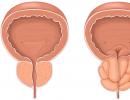Treatment methods for uterine fibroids without surgery
Uterine fibroids, although a benign tumor, pose a danger to a woman's reproductive health. Growing to a significant size, it can fill the uterine cavity, which makes it impossible to conceive or make it difficult to bear a fetus. Most often, this tumor occurs in a woman at the age when the birth of a child is included in her plans, so surgical treatment of uterine fibroids is undesirable. If the size of the tumor is small, then doctors usually choose conservative therapy or use minimally invasive methods for removing myomatous nodes.
Due to the growth of fibroids, a woman's stomach increases, as during pregnancy. The size of the tumor in cm is estimated using ultrasound and compared with the increase in the abdomen at a certain week of pregnancy. Depending on the diameter of the myomatous nodes, tumors are classified as follows:
- small fibroids - the diameter does not exceed 2-2.5 cm (respectively, the size of the abdomen is not more than at the 5th week of pregnancy);
- medium-sized fibroids - about 5 cm (10-12 weeks);
- large fibroids - larger than 8 cm (the size of the abdomen is larger than at week 12).
If a woman has a tumor of small size, then treatment is not carried out, her condition is periodically monitored by ultrasound.
Tumors larger than 8 cm (12 weeks) can be serious, causing complications during pregnancy and childbirth, miscarriage or infertility. Compression of neighboring organs and vessels leads to impaired urination, bowel function, and the occurrence of heart disease. Such tumors are eliminated by invasive methods (myomectomy, myometrectomy, hysterectomy), which involve the surgical removal of only myomatous nodes or the entire uterus.
With a tumor size of up to 8 cm (up to 12 weeks), in the absence of complications, the elimination of uterine fibroids is performed without surgery.

Methods of treatment without surgery
For treatment without surgery, medications, physiotherapeutic procedures, as well as methods of minimally invasive removal of uterine fibroids are used. There are folk remedies to relieve the symptoms of fibroids.
The use of such methods is possible in the case when the size of uterine fibroids increases by no more than 2 cm during the year, the woman does not have heavy uterine bleeding, leading to anemia. At the same time, there is no sensation of pain, disruption of the organs caused by the pressure of the tumor. It is preliminarily established that there is no danger of twisting of the tumor stem, degeneration of fibroids into uterine cancer.
Medical therapy
Hormonal agents are used, as well as drugs to alleviate the symptoms that appear during the formation of uterine fibroids.
Treatment of uterine fibroids with hormonal drugs is aimed at suppressing its growth. Most often, it does not allow you to get rid of the tumor completely. After the end of taking the drugs, it may begin to grow again. Usually, such therapy is carried out before surgical removal of the tumor to reduce the likelihood of complications during surgery.
The formation and growth of uterine fibroids contributes to the increased content of estrogens in the body. Therefore, for hormone therapy, agents that reduce their concentration are used.

For women of reproductive age, the following types of drugs are used:
- Based on androgens (gestrinone, danazol). They suppress the production of female sex hormones in the ovaries, which leads to a decrease in the size of the tumor. The course of treatment is 8 months.
- Gestagens - preparations containing progesterone (norkolut, utrozhestan, duphaston). By lowering the concentration of estrogens in the blood, they prevent the growth of uterine fibroids, as well as the accompanying endometrial hyperplasia. Treatment continues for 8 months. For the same purpose, an intrauterine device with levonorgestrel is installed (for 5 years).
- Combined oral contraceptives (Janine, Regulon) that suppress ovulation. The course of admission is 3 months.
- Preparations based on gonadotropin-releasing hormone (GnRH) of the hypothalamus (zoladex and buserelin). They weaken the functioning of the ovaries, accelerate the onset of menopause. In the absence of estrogens, uterine fibroids disappear. The drugs are used for women 50 years of age and older.
To eliminate pain caused by compression and inflammation of the organs, antispasmodics, non-steroidal anti-inflammatory drugs or analgesics are prescribed. Sedatives are used to improve the psycho-emotional state. The formation of blood clots and circulatory disorders are prevented with the help of anticoagulants. To normalize metabolism, eliminate anemia, take vitamins A, C, E, K, group B.
Minimally invasive treatment methods
Such methods involve the elimination of uterine fibroids through "operations without incisions." The tumor is destroyed through small punctures (0.5-1.5 cm in diameter).Uterine artery embolization (UAE)
A catheter is inserted through the inguinal artery, which is brought to the vessels of the tumor. A special gel is injected that clogs the vessels and stops the blood supply to the tumor. Its cells die and are resorbed. The procedure is performed under local anesthesia.

Myolysis
The method is used if there are no more than 3 myoma nodes up to 5 cm in diameter. Laparoscopic destruction of fibroids is carried out with a laser or electric current. Cryomyolysis is also used (liquid nitrogen is injected into the tumor through a probe, and it is frozen). These procedures are performed under general anesthesia. After them there are no scars.
Video: Benefits of laparoscopic removal of uterine fibroids
FUS ablation
This is a non-contact (non-invasive) treatment method that does not require any punctures or incisions. The woman is placed in the chamber of a magnetic resonance tomograph, a high-frequency ultrasonic beam is directed to the myoma. Tumor cells are destroyed and evaporated, while no effect is made on neighboring tissues. The procedure is performed without anesthesia.
The method is not used in the presence of large and numerous myomatous nodes.
Video: How FUS ablation is performed
Physiotherapy methods
In the presence of fibroids, it is impossible to carry out thermal physiotherapeutic procedures associated with increased blood flow in the body. This can lead to tumor growth.
Procedures are used that relieve inflammation of the tissues of the uterus, as well as those that help reduce the size of the tumor (therapeutic baths, electrophoresis, magnetotherapy). They are carried out immediately after the end of menstruation.
Gerudotherapy
Treatment with leeches. Due to the pressure of the tumor on the vessels, the outflow of venous blood is difficult, the veins expand, which causes pain in a woman. A little bloodletting with leeches allows you to eliminate blood stasis. Adherents of this method of getting rid of the tumor without surgery argue that the biologically active substances contained in the saliva of leeches can have a resolving effect, helping to reduce the size of the fibroids.
The method is contraindicated if a woman has anemia, poor blood clotting, low blood pressure. Such treatment should not be used if there is doubt about the benign nature of the tumor.
Folk methods of treatment
For the treatment of uterine fibroids in folk medicine, medicinal plants containing phytoestrogens, tannins, essential oils, vitamins and trace elements are used. Infusions, decoctions for oral administration, as well as formulations for douching or application with tampons are prepared from them. Valuable substances of natural origin (propolis, mummy) are also used, from which antibacterial, anti-inflammatory, immunomodulatory drugs are prepared.

Reminder: Before using folk remedies, it is necessary to consult a doctor, undergo a preliminary examination, since the substances contained in them can cause an allergic reaction or even poisoning, affect the hormonal background.
Infusion from a mixture of boron uterus and red brush
Action:
The upland uterus is a herb containing substances of anti-inflammatory, antitumor action. The red brush contains phytoestrogens, essential oils, antibacterial substances. Both plants contain many trace elements, as well as vitamins.
Application:
Dried herbs are ground into powder. Take 1 tbsp. l. each, mix and pour 1 cup of boiling water. Withstand 15 minutes on very low heat, then cool and filter, carefully squeezing the sediment. Within 2 weeks, take 1 tbsp three times a day 1 hour before meals. decoction. After a break of 1-2 weeks, you can repeat the course of treatment.
Decoction of flax seeds
Application:
4 tsp seeds are brewed with 0.5 l of boiling water, kept in a boiling water bath for 15 minutes. Drink a cooled broth half an hour before meals, ½ cup. Treatment is carried out for 2 weeks.
potato juice
Action:
It is taken as an anti-inflammatory, analgesic. Has a diuretic effect. Improves water-salt metabolism, which helps to eliminate swelling of the tissues of the pelvic organs.
![]()
Application:
Used young juicy potatoes. After thorough washing, the potatoes are peeled, grated, squeezed. Only freshly squeezed potato juice is used. It is taken in the morning, on an empty stomach, 1 glass for 3 months. Then you should take a break for 4 months, after which the treatment can be repeated. Potato juice should not be taken if there are diseases such as gastritis, diabetes.
Celandine tincture
Action:
Fibroids with a size of a few mm resolve without any surgery after 1 course of treatment. To reduce the size of a larger fibroid, you need to repeat the course after 2 months.
Application:
Pour 1 tbsp. l. finely chopped celandine 10 tbsp. l. vodka. Insist in a dark place for 2 weeks, filter.
The tincture is consumed within 30 days. On the 1st day, take 1 drop of tincture dissolved in 100 ml of water. Then the number of added drops is increased by 1 per day until they reach 15, after which they begin to decrease 1 drop every day.
To reduce the volume of uterine bleeding in fibroids, decoctions of nettle, yarrow, burdock, barberry are used.
Video: Folk recipes for the treatment of fibroids






